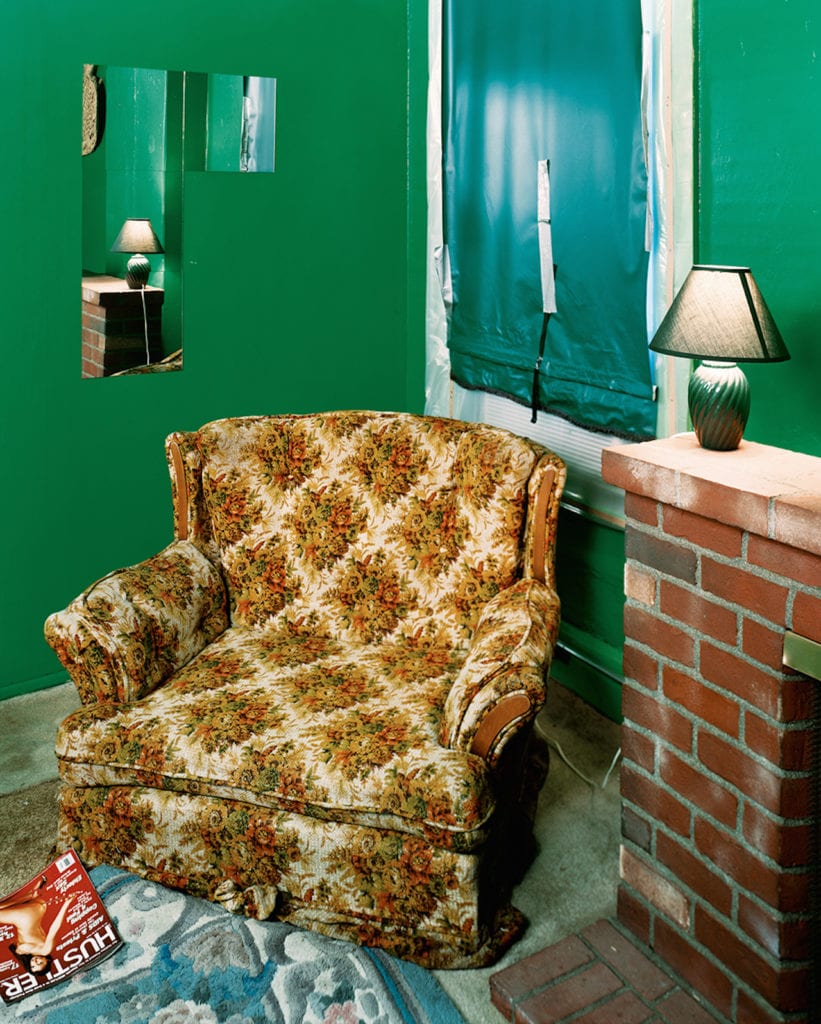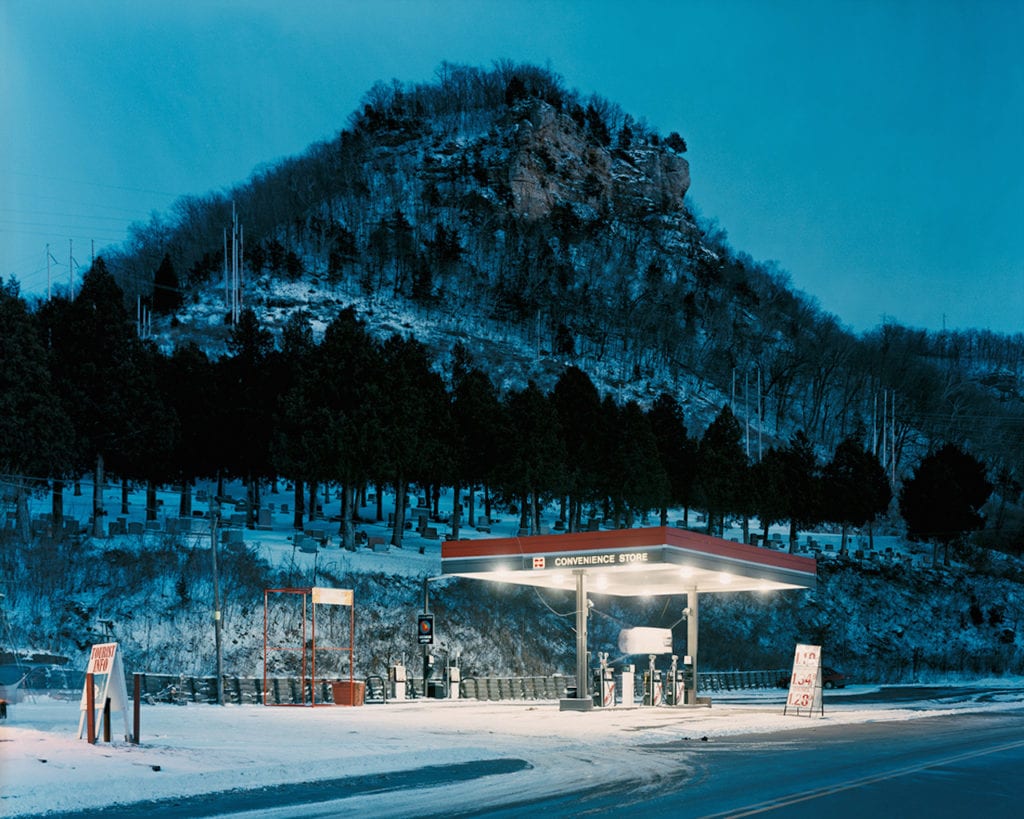Alec Soth has had a fantastic year. In March, the thirty-five-year-old photographer’s images of life on the Mississippi were the hit of the Whitney Biennial in New York. In June his book, Sleeping by the Mississippi, was published to widespread acclaim, and in the same month he joined Magnum Photos as a nominee.
Sleeping by the Mississippi has been ranked with the great representations of the United States, including Walker Evans’ pictures of the depression, Robert Frank’s harsh vision of the 1950s and, more recently, the colour work of Soth’s former teacher, Joel Sternfeld. Shot over a period of five years, Sleeping by the Mississippi is a trip along America’s ‘Forgotten Coast’, the neglected banks of the country’s longest river. In 46 immaculately-composed colour images, Soth travels from the frozen northern reaches of the river to the fecund squalor of the Mississippi Delta.
Along the way, Soth shows landscapes, interiors and portraits, most of which have a dreamlike and drained atmosphere. He alludes to religion, race, crime, sex and death, showing the lost hope, loneliness and unrealised dreams of the people he meets. “I live near the beginning of the Mississippi and have always felt a pull to it,” says Soth. “I used to run away when I was 5 or 6, pack a suitcase with books and run away from home. I’d only get a few blocks but it was the whole Huck Finn process, where the north is home and the south symbolises the exotic.
“In the beginning the project had nothing to do with the Mississippi,” he continues. “It evolved from a project called From Here to There in which one picture lead to another, linked by an idea or a theme. In the process, I travelled down the Mississippi, and I got to thinking that the idea was too gimmicky. So I shifted to the idea of the Mississippi being the link.”
But Sleeping by the Mississippi is more about the spirit of wandering and peoples’ dreams than the river itself. Throughout the project, Soth asked his subjects to write down their dreams, and this can be seen even in the first image in the book. A photograph of Peter’s houseboat in Winona, Minnesota, it shows the northern reaches of the river, where the exotic has not yet taken hold. It’s winter and the banks are covered in snow but, Peter writes “I dream of running water”.
For others, dreams mean ambition, fantasy and faith, and religion forces itself into the images throughout the book. Sheila from Leech Lake Indian Reservation stands with her arms outstretched, wearing a sweatshirt covered with hand-written Biblical quotes, and standing in front of a Bible and a picture of Christ. Sheila only agreed to be photographed if Soth accompanied the picture with the following text: ‘If you don’t have Jesus in your life, you are truly missing out on a blessing. He will set you free. Accept him today’.
But if Sheila preaches the love of Christ, Bonnie finds consolation in the tortures of hell. There, she tells Soth, ‘the fearful, and unbelieving and abominable shall have their part in the lake which burneth with fire and brimstone’ (Revelations 21:8). Soth photographs Bonnie on her sofa, her face edgy beneath a beehive hairdo. In her hands she holds a gilt-framed photograph of a cloud in the shape of an angel.
Other religious images in the book include Jesus-clad interiors, street preachers, convicts, Frankie (the sad-looking sister of TV evangelist Jimmy Swaggart), and a Memphis apartment decorated with two scratched and torn photographs of Martin Luther King – a picture of the betrayal of America’s greatest dream.
The driving force behind such images, says Soth, is curiosity. This is especially true of Soth’s images of sex, for which he was forced to overcome his natural shyness. “The first picture relating directly to sex was of Sunshine, who was a prostitute working in a motel which was obviously being used for sex. I was terrified to go into it, but I was so curious that I had to go and have a look.”
Soth shows a scantily-clad Sunshine lying on one of the motel beds, while the accompanying text tells us that her real name is Monique. She is twenty-one years old, writes Soth and “had run away from home at fourteen after the birth of her son, whom she had left with her parents. She has been Sunshine ever since.”

Indeed, one of the strengths of Soth’s work is his openness to people and ideas. He portrays people often at the fringes of society, who could be considered freaks or oddballs, but captures their ordinariness. He puts this down to the dynamics of the large-format camera he carried, which he says changed the whole relationship between him and his subjects.
“I normally don’t have a camera with me when I approach somebody, so immediately it’s less threatening,” he explains. “Then people ask me about the project and only then do they see the camera. It’s big and old-fashioned and my head is covered by a dark cloth, which also changes things. They can’t see my face, so the situation becomes more relaxed. Because it takes so long, you have a conversation with them and the result shows.
“Sometimes I asked if I could go into people’s homes and take their pictures there,” he continues. “Some of the interiors in the book started as pictures of people, but then I found their homes were more interesting. Obviously you can’t just ask people to go into peoples’ homes and take their pictures.”

Personal circumstances also influenced the work Soth produced. “My mother-in-law lived with me and my wife for years while she was ill with cancer and during a leave of absence she got very, very ill. I was at her deathbed and it changed my work. I became more courageous and the death theme emerged very strongly.”
Death is everywhere in Soth’s work. There are cemeteries, gravestones, memorial murals and a landscape of the cobbled banks of the Mississippi where the singer Jeff Buckley swam to his death. An old hospital bed in a deserted farmhouse echoes the time Soth spent at his mother-in- law’s death bed, while a sad portrait shows Lenny, a muscle-bound construction worker and erotic masseur, whose teenage son had recently died in a traffic accident. “My dream,” wrote Lenny, “is to live to be 100 and still look the way I do now.”
Soth’s dream was to make a great book. Having got his images together he produced 50 inkjet books in spring 2003 and gave them away. “People responded to them very quickly and soon publishers were interested,” he says. “I approached Steidl and the book came out. It was like a dream come true.”
Since then, Soth’s dream has entered the realms of fantasy. Rejecting the imprecations of the art world, he joined Magnum as a nominee. “I chose Magnum because I’m in love with that whole tradition,” he says. “I always remember what Capa said to Cartier-Bresson: ‘Don’t keep the label of a surrealist photographer. Be a photojournalist. If not, you will fall into mannerism. Keep surrealism in your little heart, my dear’. I do have the capacity to be self-indulgent and I can be over-poetic, so it’s really healthy to do assignments.”
Soth’s latest project is on newly-weds honeymooning at Niagara Falls but with Sleeping by the Mississippi, he has already created a classic. Focusing on universally-recognisable themes, it transcends its American roots to become a book that is accessible to every one, the first work from a man with the charm, vision and intelligence to become one of the truly great photographers.



